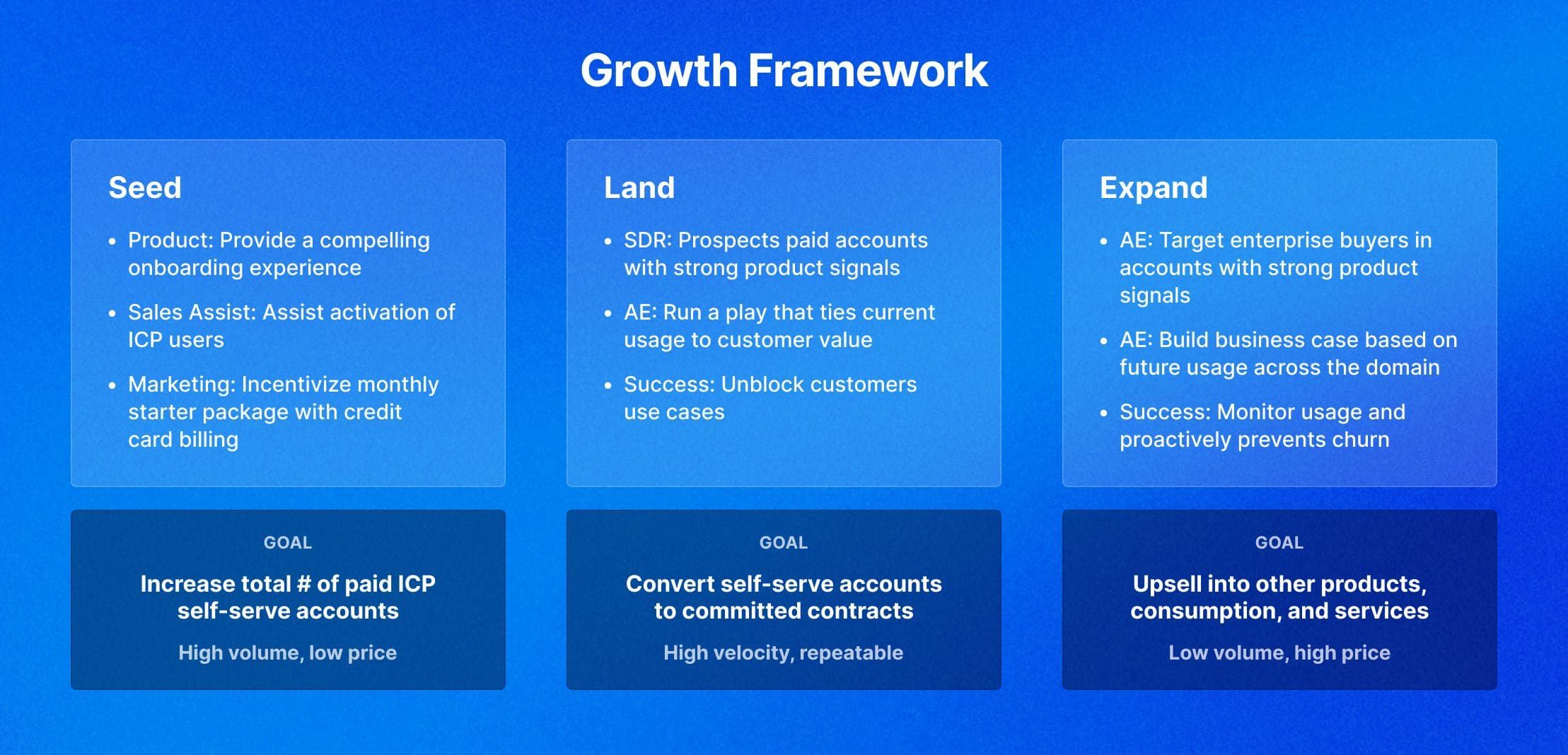
Company Updates
Company Updates
Seed, land, and expand framework for product-led sales
September 6, 2022
Andrew Johnston
In this guide, Andrew Johnston shares a framework for how to seed, land, and expand deals with product-led sales so that as customers realize more value in product, it's easy for them to buy more.
To drive sustained growth in B2B SaaS, you have to continually increase revenue of your install base. The key to doing this at scale is by building a product-led sales motion where as customers increase adoption and realize value, it’s easy for them to buy more.
In this framework, I’m going to lay out how revenue teams at software companies can achieve this by seeding ICP customers, landing initial deals, and expanding across product lines and services.

3 operating principles for product-led sales
As you implement product-led sales, it’s important to keep in mind a few operating principles that have led to incredible results that I’ve seen during my time at Sendgrid, Twilio, and now Scale AI.
1. Product-led sales requires a cross-functional approach
The product experience is always a factor in product-led sales. This means that the sales leader needs to work with product, success, ops/analytics, and assist teams to make sure that each function, the buyer journey, and the product experience are aligned.
Running a product-led sales motion in siloes doesn’t work – not for your customers or for your ability to find repeatability or long-term upside in your sales motion.
2. Having a midwestern style is key
Monetizing existing users takes an approach that isn’t too relaxed, but also isn’t aggressive. It’s about putting the customer first, unblocking them so they see success using your product, and then using that trust to push for growth that makes sense for both parties.
I call this the midwestern selling approach. You come in soft to land an initial deal, but you have the sales fundamentals, rigor, and customer relationships to grow the account into a banner logo.
3. Commit plays a huge role in revenue expansion
When consumption is a pricing lever, commitment helps sales teams grow accounts more effectively by putting skin in the game for the customer. This makes them more likely to be successful and sets up sales to be a partner instead of a seller.
Long term contracts don’t have to be a bad thing. In reality, unless your business has extremely low churn or switching costs/effort are high, it’s important to build in a “commit” sales cycle into your motion.
This accomplishes two things:
Builds sustaining ARR and reduces churn
Establishes a partnership by prioritizing resources and features for committed customers
How to close seed deals in product-led sales
Seeding deals in product-led sales is not about revenue. The goal is to increase the total number of paid ICP accounts in the self-serve funnel. Think of seed deals as a pipeline source that fuels your sales team. Without continually growing seed deals, you’ll run out of customers to land and expand in the future.
The key to land seed deals is to deliver a great experience that drives habitual use of the product and then incentivize a path to purchase. This can be done purely through self-serve or with sales assist to provide an additional nudge for customers who fit the ICP.
Roles and responsibilities
Product: Provide a compelling onboarding experience that decreases time to activation
Sales Assist: Find ICP users who aren’t fully activated and reach out based on their product usage
Marketing: Incentivize a monthly starter package that offers access to new features with credit card billing
The objective is to get the customer incrementally more committed to your product by getting them to a product yes quickly. Then, offer a simple conversion path to paid that unlocks new functionality. This gets the customer to love the product and acclimates them to paying for it.
How to land deals in product-led sales
Velocity and simplicity of the sales motion are critical to close land deals. Surfacing product signals and making them actionable for sales is critical to identify which accounts and users within the paid user base are ready to talk to sales.
The goal is to tie product usage to a clear win for the customer, leverage commit to land a small deal, and set the customer up for success long term.
Roles and responsibilities
SDR: Prospects paid ICP accounts with recent changes, increased consumption, or adoption of premium features.
AE: Run a product-led sales motion that ties product usage to clear value for the customer and provides a path forward in product
Success: Helps unblock customers and ensure the product is delivering on the success criteria laid out in the sales cycle
You don’t want to reach for the highest contract value possible at this stage. Rather, land deals are the hook that creates groundswell within an organization and leads to material expansion opportunities down the road.
SDR and sales teams can use recent changes in product signals to focus efforts on accounts where sales has the most leverage. This helps increase the velocity of land deals which is critical to scaling revenue.
Examples of product signals for prospecting land deals:
Accounts that sales previously engaged with surging product usage
Accounts that exceed specific consumption thresholds
Accounts that start running tests/experiments or using premium features
Land motion at Sendgrid
Two signals we used to run a land play were email deliverability issues and consumption thresholds. If an account was trying to send more emails than they paid for or were seeing more an influx in errors, sales stepped in and offer the next product tier with better functionality and offer guidance on how they unblock their use case.
AEs had the product knowledge to create trust with our developer audience, and developers came away surprised to have learned something. It was a powerful tool and something that set us apart, increased NDR, and lowered churn.
How to expand deals in product-led sales
Expansion in product-led sales is about identifying the accounts that are committed to a certain level of usage and looking for the next challenges you can help solve for them.
The primary difference between expand deals and land deals in this framework is that expansion is about establishing a partnership that unlocks new ways to work together. This improves retention for key accounts and up-levels your competitive differentiation.
Roles and responsibilities
AEs: Monitor product signals and target enterprise buyers at high leverage accounts
AEs: Build a business case based on product-usage across the entire domain – not just individual workspaces or users
Success: Monitors WoW and MoM usage and proactively engages accounts to prevent churn and increase upsell opportunities
Marketing: Make customers aware of the product they’ve signed up for, other packages or products offered, and additional services
Consider organizing AEs as different functions focused on seed, land, and expansion deals. Layering on teams that are experts on each motion will improve throughput, repeatability, and velocity.
Building the cross-sell motion at Twilio
After Twilio acquired Sendgrid, the enterprise team ran the first cross-sell play with both products. The goal was to find usage and identify accounts inside of Twilio that are ripe for email notifications.
The cross-sell play that we ran with AEs was to identify accounts who used one Twilio/Sengrid for either SMS or email and another competitor for the opposite use case.
The sales motion led to powerful playbook for cross-selling Sendgrid to Twilio customers:
Look at accounts with low deliverability rates using competitors
Communicate to Twilio customers that they are hitting the spam inbox at a specific frequency
Suggest switching to Sengrid at a lower cost, single vendor, and better deliverability
If sales closed the deal, they had 30 days to upsell deliverability services and support packages. Customers that engaged with sales and purchased services had an outsized LTV and lower churn rate than those who did not, which was a win-win for growth and customer success in a highly commoditized category.
Final thoughts
Building a modern product-led sales motion isn’t rocket science. You need to have a great inbound funnel and continually drive awareness, and getting customers to success in your product is the best way to do that.
Cross-functional alignment is key to make sure everything is mapped and done appropriately, and the role of sales is to engage at the right time to unblock the customer. This creates value opportunities to commit the customer and upsell to a future state. From there, rinse and repeat.
Andrew Johnston is a product-led sales expert with experience building and managing scaling sales teams in developer focused and technical SaaS products from seed to public company. He is currently Director of Sales at Scale AI.
In this guide, Andrew Johnston shares a framework for how to seed, land, and expand deals with product-led sales so that as customers realize more value in product, it's easy for them to buy more.
To drive sustained growth in B2B SaaS, you have to continually increase revenue of your install base. The key to doing this at scale is by building a product-led sales motion where as customers increase adoption and realize value, it’s easy for them to buy more.
In this framework, I’m going to lay out how revenue teams at software companies can achieve this by seeding ICP customers, landing initial deals, and expanding across product lines and services.

3 operating principles for product-led sales
As you implement product-led sales, it’s important to keep in mind a few operating principles that have led to incredible results that I’ve seen during my time at Sendgrid, Twilio, and now Scale AI.
1. Product-led sales requires a cross-functional approach
The product experience is always a factor in product-led sales. This means that the sales leader needs to work with product, success, ops/analytics, and assist teams to make sure that each function, the buyer journey, and the product experience are aligned.
Running a product-led sales motion in siloes doesn’t work – not for your customers or for your ability to find repeatability or long-term upside in your sales motion.
2. Having a midwestern style is key
Monetizing existing users takes an approach that isn’t too relaxed, but also isn’t aggressive. It’s about putting the customer first, unblocking them so they see success using your product, and then using that trust to push for growth that makes sense for both parties.
I call this the midwestern selling approach. You come in soft to land an initial deal, but you have the sales fundamentals, rigor, and customer relationships to grow the account into a banner logo.
3. Commit plays a huge role in revenue expansion
When consumption is a pricing lever, commitment helps sales teams grow accounts more effectively by putting skin in the game for the customer. This makes them more likely to be successful and sets up sales to be a partner instead of a seller.
Long term contracts don’t have to be a bad thing. In reality, unless your business has extremely low churn or switching costs/effort are high, it’s important to build in a “commit” sales cycle into your motion.
This accomplishes two things:
Builds sustaining ARR and reduces churn
Establishes a partnership by prioritizing resources and features for committed customers
How to close seed deals in product-led sales
Seeding deals in product-led sales is not about revenue. The goal is to increase the total number of paid ICP accounts in the self-serve funnel. Think of seed deals as a pipeline source that fuels your sales team. Without continually growing seed deals, you’ll run out of customers to land and expand in the future.
The key to land seed deals is to deliver a great experience that drives habitual use of the product and then incentivize a path to purchase. This can be done purely through self-serve or with sales assist to provide an additional nudge for customers who fit the ICP.
Roles and responsibilities
Product: Provide a compelling onboarding experience that decreases time to activation
Sales Assist: Find ICP users who aren’t fully activated and reach out based on their product usage
Marketing: Incentivize a monthly starter package that offers access to new features with credit card billing
The objective is to get the customer incrementally more committed to your product by getting them to a product yes quickly. Then, offer a simple conversion path to paid that unlocks new functionality. This gets the customer to love the product and acclimates them to paying for it.
How to land deals in product-led sales
Velocity and simplicity of the sales motion are critical to close land deals. Surfacing product signals and making them actionable for sales is critical to identify which accounts and users within the paid user base are ready to talk to sales.
The goal is to tie product usage to a clear win for the customer, leverage commit to land a small deal, and set the customer up for success long term.
Roles and responsibilities
SDR: Prospects paid ICP accounts with recent changes, increased consumption, or adoption of premium features.
AE: Run a product-led sales motion that ties product usage to clear value for the customer and provides a path forward in product
Success: Helps unblock customers and ensure the product is delivering on the success criteria laid out in the sales cycle
You don’t want to reach for the highest contract value possible at this stage. Rather, land deals are the hook that creates groundswell within an organization and leads to material expansion opportunities down the road.
SDR and sales teams can use recent changes in product signals to focus efforts on accounts where sales has the most leverage. This helps increase the velocity of land deals which is critical to scaling revenue.
Examples of product signals for prospecting land deals:
Accounts that sales previously engaged with surging product usage
Accounts that exceed specific consumption thresholds
Accounts that start running tests/experiments or using premium features
Land motion at Sendgrid
Two signals we used to run a land play were email deliverability issues and consumption thresholds. If an account was trying to send more emails than they paid for or were seeing more an influx in errors, sales stepped in and offer the next product tier with better functionality and offer guidance on how they unblock their use case.
AEs had the product knowledge to create trust with our developer audience, and developers came away surprised to have learned something. It was a powerful tool and something that set us apart, increased NDR, and lowered churn.
How to expand deals in product-led sales
Expansion in product-led sales is about identifying the accounts that are committed to a certain level of usage and looking for the next challenges you can help solve for them.
The primary difference between expand deals and land deals in this framework is that expansion is about establishing a partnership that unlocks new ways to work together. This improves retention for key accounts and up-levels your competitive differentiation.
Roles and responsibilities
AEs: Monitor product signals and target enterprise buyers at high leverage accounts
AEs: Build a business case based on product-usage across the entire domain – not just individual workspaces or users
Success: Monitors WoW and MoM usage and proactively engages accounts to prevent churn and increase upsell opportunities
Marketing: Make customers aware of the product they’ve signed up for, other packages or products offered, and additional services
Consider organizing AEs as different functions focused on seed, land, and expansion deals. Layering on teams that are experts on each motion will improve throughput, repeatability, and velocity.
Building the cross-sell motion at Twilio
After Twilio acquired Sendgrid, the enterprise team ran the first cross-sell play with both products. The goal was to find usage and identify accounts inside of Twilio that are ripe for email notifications.
The cross-sell play that we ran with AEs was to identify accounts who used one Twilio/Sengrid for either SMS or email and another competitor for the opposite use case.
The sales motion led to powerful playbook for cross-selling Sendgrid to Twilio customers:
Look at accounts with low deliverability rates using competitors
Communicate to Twilio customers that they are hitting the spam inbox at a specific frequency
Suggest switching to Sengrid at a lower cost, single vendor, and better deliverability
If sales closed the deal, they had 30 days to upsell deliverability services and support packages. Customers that engaged with sales and purchased services had an outsized LTV and lower churn rate than those who did not, which was a win-win for growth and customer success in a highly commoditized category.
Final thoughts
Building a modern product-led sales motion isn’t rocket science. You need to have a great inbound funnel and continually drive awareness, and getting customers to success in your product is the best way to do that.
Cross-functional alignment is key to make sure everything is mapped and done appropriately, and the role of sales is to engage at the right time to unblock the customer. This creates value opportunities to commit the customer and upsell to a future state. From there, rinse and repeat.
Andrew Johnston is a product-led sales expert with experience building and managing scaling sales teams in developer focused and technical SaaS products from seed to public company. He is currently Director of Sales at Scale AI.
Share this article
See also
Load More
Load More
Load More


